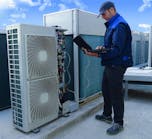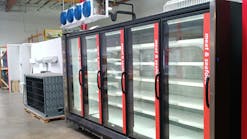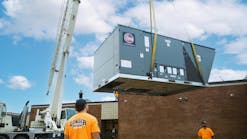by Colleen Julian
Unlike many types of HVAC equipment that are tucked away in an indoor mechanical room, package units are typically located on building rooftops or at ground level on concrete slabs. Because of their exposure to the elements, these units have to endure harsh conditions.
Develop a routine maintenance schedule before initial operation. Maintenance should only be performed by qualified service personnel. Base the schedule on hours of operation, conditions under which the units run, and include a service log. Service logs provide invaluable information regarding unit history, troubleshooting and tracking scheduled maintenance.
This article focuses on seasonal maintenance requirements for the major components of gas heat/electric cooling rooftops. Service technicians should follow the recommendations of the OEM.
Service tools.To perform seasonal maintenance on rooftop units, a variety of tools are required. Some of these include a ladder with various sized extensions to provide access to the building rooftop; an accurate manifold pressure gauge and thermometer to allow the measurement and verification of proper refrigerant charge; and a belt tension gauge and straight edge to measure belt tension and pulley alignment. See the chart on the following page for additional tools required.
Service safety. Before servicing any rooftop unit, be sure to shut off all electrical power to the unit and tag the disconnect to avoid shock hazard or injury from rotating parts.
Overall unit. Because the units are located outdoors, the unit exterior should be inspected at the beginning of each cooling and heating season. Remove any foreign debris such as leaves, paper, etc. Make sure all access panels are securely fastened. If the unit doesn’t contain hinged doors, inspect the panels for missing screws and replace where needed.
Heating and Cooling Season Maintenance Tips
At the beginning of each heating and cooling season we suggest the following maintenance:
Evaporator coil. Inspected this coil to ensure proper cooling capacity levels. Clean it on an as-needed basis using a commercial coil cleaner or dishwasher detergent in a pressurized spray canister. Wash both sides of the coil and flush with clean water. For best results, backflush toward the return-air section to remove foreign material. Be careful not to overflow the evaporator drain condensate pan.
Condenser coil. Inspected the condenser coil monthly and clean it annually as required by location and outdoor air conditions. This cleaning ensures proper condensing temperature, eliminates both low capacity level and poor efficiency. Wash one-row coils with a commercial cleaner. For coils with multiple rows, use a water hose or other suitable equipment to flush down between multiple sections to remove dirt and debris.
Filters. Filters should be cleaned or replaced at the start of each cooling and heating season, or more often if operating conditions require. To determine the frequency, visually inspect or measure the airside pressure drop. Clean filters prevent dirt buildup on coils and help with the indoor air quality of the occupied building space. Follow the manufacturer recommendation for filter size and type.
Outdoor air inlet screens. Annually clean inlet screens with steam or hot water and mild detergent. Inspect monthly to determine if more frequent cleaning is required.
Compressors. Charge the compressor(s) with the correct amount of oil at the factory. With semi-hermetic compressors, refer to the manufacturer instructions for checking proper oil level.
Fan motor bearings. Depending on the type of unit, the fan motor bearings may be of the permanently lubricated type. If the bearings are not permanently lubricated, lubricate every six months with suitable bearing grease or oil. See the manufacturer recommendation on oil manufacturer and type to use.
Condenser fan. Check the condenser fan height annually to prevent re-circulation of condenser air and maintain the capacity and efficiency of the unit.
Evaporator fan. Inspect the evaporator fan to ensure it’s centered in its housing. Annually lube the evaporator fan motor, if needed.
Blower belt. Inspect the blower belt for wear, proper tension, and pulley alignment at the beginning of each cooling and heating season, or as conditions require. Replace worn belts. Don’t run them to the point of breakage. Annual inspections will indicate how often to replace belts.
Thermostatic expansion valve (TXV). If the unit contains thermostatic expansion valves, check each circuit to ensure the bulb is secure and insulated and in the correct position per the manufacturer recommendation. Most TXVs are factory set, non-adjustable, and require no service.
Economizer. If the unit contains an economizer, perform an annual cycle run-through to ensure the actuator, dampers and temperature sensors are operating correctly. Also check the ventilation settings.
Refrigerant charge. Check the refrigerant charge annually to make sure it is at yhe proper level. Before checking charge, run the unit for 15 minutes in the cooling mode to stabilize system pressure. The correct amount of refrigerant charge is listed on the unit nameplate. Use the manufacturer’s cooling charging chart to determine if additional refrigerant is required.
When evaluating the charge, adjustment to the specified factory charge must always be minimal. If a substantial adjustment is indicated, an abnormal condition exists somewhere in the cooling system, such as a refrigerant leak or insufficient airflow across either the coil or both coils.
Heating Season Maintenance Tips
At the beginning of each heating season we also suggest the following maintenance on your rooftop unit:
Flue gas passageways. Annually inspect the flue collector box and heat exchanger. Clean all surfaces on an as-needed basis using a wire brush.
Combustion air-blower. For proper airflow and efficiency, clean the combustion air-blower. Inspect the blower wheel every fall and periodically during the heating season. For the first heating season, inspect the blower wheel bi-monthly to determine the proper cleaning frequency. The blower wheel can be inspected by shining a flashlight into the draft hood opening.
Temperature limit switch. Test the temperature limit switch and verify the operation of the limit by temporarily blocking the return air until the limit trips.
Main Burners. Inspect the main burners for deterioration or blockage due to corrosion or other causes. The main burner flames should be observed and adjusted if necessary.
Cooling Season Maintenance Tips
At the beginning of the cooling season also pay careful attention to the:
Condensate drain. Check and clean at the pan at the start of the cooling season. Keep it dry and protected in the winter to prevent freeze-up.
Proper and routine scheduled maintenance ensures longevity and peak performance of a building’s rooftop units. Cleaning, inspecting, and adjusting major components at the beginning of each season are the means to do this. By planning your maintenance schedule and following manufacturer’s recommendations, you can rest assured that you’re taking proper care of your customer’s rooftop investment. n
Colleen Julian is the Upstate New York- area service sales manager for Carrier Corp., based in Syracuse, NY. She can be reached by e-mail at [email protected].








